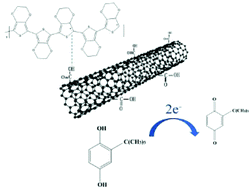A poly(3,4-ethylenedioxythiophene)/carbon nanotube hybrid film for electrocatalytic determination of tertiary butylhydroquinone†
Abstract
The preparation of ideal sensing materials is of great significance for the realization of high-performance electrochemical analysis. However, in previous methods, most electrode materials are firstly synthesized and dispersed, finally dropped on the electrode surface, which led to complicated operation and poor adhesion between the materials and electrode surface. In this study, a PEDOT–CNT hybrid film has been prepared by combining carboxylated carbon nanotubes as dopants with PEDOT through scalable and easy-to-operate electrochemical deposition. The PEDOT–CNT modified electrode shows excellent performance for the determination of tertiary butylhydroquinone, with a wide linear range of 0.5–820 μM, a low detection limit of 0.12 μM, high stability and reproducibility. In addition, the mechanism of electrodeposition of CNTs and tertiary butylhydroquinone has also been discussed briefly. The PEDOT–CNT hybrid film possesses the preeminent sensing capacity in monitoring tertiary butylhydroquinone, providing research clues for the design and development of new electrode materials in the future.



 Please wait while we load your content...
Please wait while we load your content...